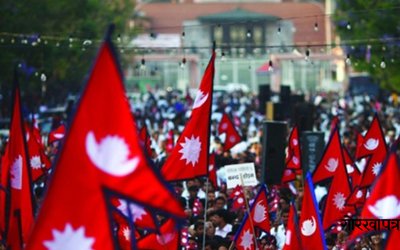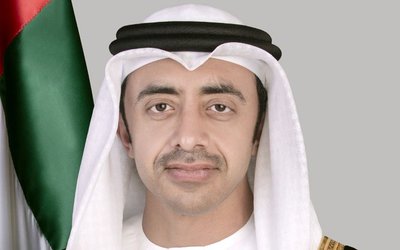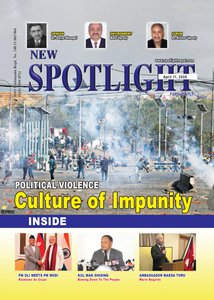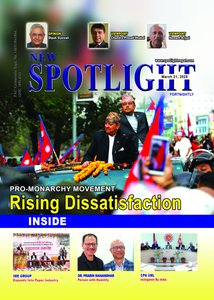As you read this column, it will be well into the second month after elections for CA-II with the doldrums continuing. Not only is there no newly mandated and freshly minted government, there is no sign that the CA-cum-parliament can even convene anytime soon. Among other contradictions lurking under the carpet, an unseemly row has erupted into the open about who should summon this body to convene for its first sitting: the past “sell-by” date-expired president who has successfully given the impression that he belongs not to all but to only one faction of the Kangress or the incumbent “acting” prime minister and chief-justice-in-suspension universally hated by his legal fraternity? As they say in Bollywood, this is only the “trailer” (preview) of the circus that awaits Nepalis in the months ahead.
When it finally does convene, the new revolutionary MPs, from Cash Maoists to Kangresis, will be sworn their oath of office by the oldest among the MPs, the former Maha Pancha Surya Bahadur Thapa, a many-times prime minister under both the direct and constitutional monarchy dispensations who opportunistically switched to revolutionary republicanism. It will be a sight to watch, these strange bedfellows legitimating each other. Stranger it has been to watch the confused silence among otherwise loquacious self-styled “international community” that backs them, a sign of their belated (but publicly unadmitted) realization that this Loktantrick adventurism of theirs is yielding nothing but political miscarriages and inherent instability.
Globally, if 1989 ushered in the Age of Democracy and human rights, 2014 is ushering serious questioning of what effective governance means, and where individual human responsibilities have to compromise with societal rights. It is not just Nepal where this Westminster model of democracy is showing fatigue and failure. Bangladesh and Thailand are also showing that “elections at all costs” without addressing the flaws in their foundational architecture fail to provide any governance at all and only tear the social fabric apart. Even in India, touted as the beacon of this mode of governance, not all is well. Grassroots Maoist insurgency in half of its districts, a mood of alienation in its Himalayan rim states from the Indus to the Brahmaputra and a colonial legacy administration that further impoverishes the poor and enriches its rich and the middle-class “green card” holders are bitter realities that do not quite make the world’s “largest” democracy more attractive to the former non-aligned countries.
And it is doubtful if the middle-class frustration with blatant corruption, expressed through the maverick populist politics of Aam Admi Party in in urban Delhi, can stem the rot without Indians asking deeper questions about traditional values, how they underpin good governance and why ignoring them will only create faulty foundations on which no new architecture can be erected. Only Mao in China (who, Marxist garb notwithstanding, in effect re-crafted the Confucian system) and King Mahendra in Nepal (whose creations still underpin Nepal’s badly mauled governance) managed to successfully bring about indigenous systems of governance, of which only Mao’s survives in the neighbourhood. Mao’s ‘Dash’ acolytes in Nepal, who reject the Westminster model as “a butcher’s shop that puts goat’s head on display and sells dog’s meat”, have strengthened their “We told you so!” position with the current doldrums; but it is doubtful if they can come up with a viable model without accepting and coming to terms with Nepali history and traditions.
A chance was missed in 1990 when leaders still with some political gravitas chose the easy route of replaying 1959 instead of learning lessons from thirty years of Panchayati stability and re-crafting a suitable system. Human rights activist Kapil Shrestha ironically blames King Mahendra for it: he dismissed that system too quickly in 1960 without letting the Kangress and Communist leaders appreciate its flaws, which they remained blind to right up to the end of the 20th century. A bigger chance was missed in 2008/2010 because that change – it is nakedly obvious now thanks to the likes of S.D. Muni and the author of Prayogshala or Chakrabhiu ma Chandra Surya –was brought about through devious international machinations while Maoist and Seven Party Alliance leaders functioned as their loyal political bureaucrats genuflecting before the “badhyata” of external political dictates.
There is a need for serious stock-taking following the November elections and the sinkholes that are opening up in Nepali politics that indicate some deeper subterranean caving in. Some important lessons quickly need to be learnt from the “peoples’ verdict”. The first is that, in the absence of a run-off system between top two contenders until one emerges with over 50 percent of the votes, the winners don’t really represent the people. In an average electoral constituency of some fifty thousand voters, the ones that actually turn up to vote and whose vote is not invalidated are about 35 thousand. When there are over a dozen candidates in the field, the winner that is ‘first-past-the-post’ could win with as little some four thousand votes, meaning he or she represents the choice of just a little more than ten percent of the voters, the threshold for them not to forfeit their deposits. In the current situation where the remedy of proportional representation stands discredited due to the party oligarchs penchant for nominating their henchmen, this lacunae in the directly elected system is a serious challenge to the legitimacy of the overall Loktantrick system, and one that the energized “excluded” ninety percent will not take kindly.
Take the case of Mahottari-4 where an irony has played out. Independent candidate Chandreshwar Jha won the elections with 3062 votes but that being less than ten percent of the votes cast, he (together with all other candidates) forfeited their deposits. He will thus represent the people of Mahottari in CA-II and, if it ends up making a new constitution with his help, it will be termed a “peoples’ constitution”. Unfortunately, Vaidya’s Dashists will use Jha and his case – a deposit-forfeiting candidate is a winning MP – as a “poster boy” for their campaign of boycott and delegitimizing of CA-II.
The case of Kapilvastu-2 is just as bizarre. It is a constituency with some 44 thousand voters, of which some 32 thousand cast valid votes. Akhtar Hussein Kamal was a popular Nepali Kangress social worker, but the party denied him an official ticket. He stood as a rebel independent candidate with the lock as his election symbol. During the voting, he displayed his ballot paper publicly showing he had voted for the Kangress symbol of the tree and not his lock. However, his admirers voted for him and he emerged first, winning some 4674 votes. The other candidates forfeited their deposits, including the Nepali Kangress’s official candidate who came ninth! What this highlights is the utter lack among big party oligarchs of any touch with the grassroots sentiments or a feel for the pulse of the people. Initially, the Kangress and UML leaders were in awe and shock at the scale of their victories and the decimation of the Maoists as well as the regional parties. Now, before the House has even convened and the government even formed, they are gloating and fighting for political spoils of office.
When one combines these deep contradictions of Loktantrick politics and the sub-optimal level of vision among the elected and selected representatives to the CA-II with the burden of unimaginably high expectations on a new constitution they are supposed to draft, one ends up with a toxic impasse. The party oligarchs have made the constitution the mythical elixir when it is just a charter of rules for civilized relations between the citizens and those who hold public office to serve that compact. It cannot be a magic wand to solve all the ills of society, but the political hype since the start of this century has been that the CA will make it even more magical than the erstwhile “best in the world” 1990 constitution.
How can the wisdom of what the philosopher of freedom Karl Popper said be brought home to the political oligarchs of all big parties– that one cannot create a perfect Platonic republic, that it will always be imperfect, and that the task of all freedom loving people is to constantly strive to improve it by minimizing misrule and misuse of power by those who rule? Indeed, would that not be a simpler and more profound agenda than the current quixotic pursuit, and one that would allow the rest of the country to get on with the business of individual and collective development? And where best to start for the majoritarian Kangress and the UML than with the constitution they framed in 1990 calling it the “world’s best”, and now with the wisdom of hindsight – and hopefully the humility of self-criticism – to improve upon it with piecemeal practice?

Dipak Gyawali
Gyawali is Pragya (Academician) of the Nepal Academy of Science and Technology (NAST) and former minister of water resources.
- Re-Thinking Democracy: Why South Asians Are worried
- Mar 17, 2025
- Nepal’s Governance Mired In Endemic Corruption
- Feb 20, 2025
- What Might The Age Of Trump Look Like?
- Jan 22, 2025
- Kathmandu Dialogue With Dugin
- Dec 25, 2024
- Bioregionalism Satsang
- Sep 27, 2024














